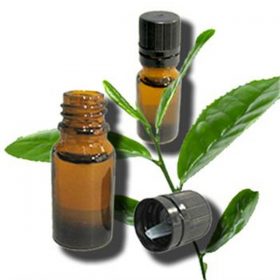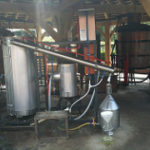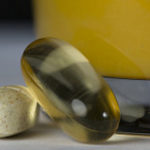Love Essential Oils? Learn A Little About Their Chemistry!
Chemistry. Already getting nervous? The chemistry chapters of essential oil texts are the most frequently skipped, even by natural health professionals. But it can be fun and useful…really! Knowing what essential oils are made of, and how this affects their aroma and therapeutic value can have a big impact on the efficacy of your aromatherapy practice. Understanding the basics can help you make better choices in essential oils, and better choices in their application. Plus, this can give you the foundation for further understanding of true “medical aromatherapy”, as practiced in much of the rest of the world. So here’s a primer on the chemistry of essential oils, with some common examples and important tips to help you grow as a holistic medicine practitioner.
So, why are essential oils called “oils” anyway? They don’t feel greasy, and they tend to evaporate completely, unlike common “fixed” oils (such as olive, grapeseed, hazelnut and the like). Essential oils and fixed oils share a similar chemical foundation: their structures are based on the linking of carbon and hydrogen atoms in various configurations. But this is really where the similarity ends. Fixed oils are made up of molecules comprised of three long chains of carbon atoms bound together at one end, called a triglyceride. Every fixed oil is made up of just a few different triglyceride arrangements – olive oil, for example, is primarily made up of oleic, linoleic and linolenic acids (the names of particular carbon-hydrogen chains forming the triglycerides). Their long-chain shape holds them in a liquid state which does not easily evaporate.
Essential oils are “volatile” oils – oils that DO easily evaporate. Their chains of carbon atoms to which the hydrogens attach are not as long or heavy, but are much more complex. Many essential oil structures are not really chains, but ring, or multi-ringed shapes with diverse sub-units – called “functional groups” – sticking out in various directions. Like their fixed oil counterparts, essential oils are lipophillic – meaning “fat liking”. The fat-liking nature of both fixed and essential oils makes them easily absorbed by our bodies. Because of their typically smaller structures however, essential oils are absorbed more rapidly than fixed oils, and can easily penetrate deep into the body.
The therapeutic action of an essential oil is primarily determined by the “functional groups” found in the molecules that make up that oil. An essential oil is actually made up of many individual molecular constituents. Each of these natural chemicals is formed of a carbon-hydrogen structure with a functional group attached. It is the combination of the base structure AND the attached functional group that makes a single, unique molecule. And MANY of these unique molecules combine to form ONE essential oil.
As you can see, essential oils are really very complex in their chemical nature. There are nearly infinite possibilities of functional group and base ring or chain combinations. And ONE essential oil alone can be made up of HUNDREDS of these different molecular arrangements. Don’t worry, though! While it sounds complex, one needn’t know all the precise chemical details to use essential oils therapeutically. Just know that any single essential oil is comprised of a few natural chemicals that make up the bulk of the oil, and many minor “trace” constituents that also affect both aroma and therapeutic activity.
The best natural, undiluted, properly distilled essential oils with all the major and minor chemical constituents will have the finest aromas AND the most potent therapeutic action. Many factors in an essential oil’s production affect the total number and relative amounts of individual chemicals found in the final product. These include where the plant was grown, soil and climate conditions, time of harvest, distillation equipment, plus the time, temperature and pressure of distillation. This can give you an idea as to why two varieties of the same oil can smell so different: The full, beautiful bouquet of a fine essential oil will contain a myriad of notes, telling you that all natural components are present and in balanced amounts.
To best understand this, we’ll examine Lavender essential oil; more than fifty individual molecules have been identified in pure lavender essential oil. The aromatherapist must remember that ALL of these chemicals found in pure and natural Lavender oil work together to produce a therapeutic effect. For example, the linalool molecule is antiviral and antibacterial; the linalyl acetate is emotionally calming; other major components including cineol, limonene, pinene and others are all noted for specific biologic and aromatic activity. It is the combined, balanced, synergistic action of these chemicals that make pure, high-quality Lavender such a great healer.
What does this mean to the lay-practitioner? That it’s important to find a nice smelling lavender oil! Each individual chemical, both major and minor, has a distinct smell, and is talked about in terms of “notes” within the overall lavender aroma. Some of these are sweet, some citrusy, some are herbaceous, and some camphorous (and the list goes on). A precise amount of each will create a certain Lavender aroma. Some lavenders are more sweet (and may therefore more relaxing), others are more herbaceous. Your nose is an incredible detector of essential oil chemistry, and you’ll be surprised how effective it is at choosing the finest, most therapeutically valuable oil. Your nose can tell you if all the constituents are in balance, if the oil is fresh, and interestingly, also if the oil is right for you – trust yourself in this regard!
A balanced approach in aromatherapy, as in all of natural medicine, is best. The most effective practitioner will have a well-developed “internal pendulum” combined with a solid education. Significant variations exist in the quality of essential oils; it is really cost effective to buy the higher grades of oil, as their synergy of expertly distilled chemicals will have the greater therapeutic action. Use your nose, knowledge and intuition to find a source you trust, that delivers consistently high-grade oils for a reasonable cost. Use these same faculties to skillfully select and apply the appropriate oil for each circumstance. Essential oils are complex by nature; at the same time, they have an exceptionally broad scope of therapeutic applications. Hopefully, this little bit of aromatherapy chemistry will enrich your ability to support your own health, and the health of those around you.










Leave a reply